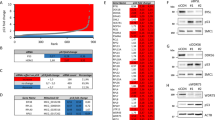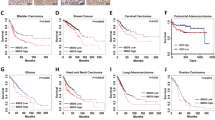Abstract
Several ribosomal proteins regulate p53 function by modulating MDM2. We recently found that RPS27L, a RPS27-like protein, is a direct p53-inducible target. Here we showed that RPS27 itself is a p53-repressible target. Furthermore, the N-terminal region of either RPS27L or RPS27 binds to MDM2 on the central acidic domain of MDM2. RPS27L or RPS27 forms an in vivo triplex with MDM2-p53 and competes with p53 for MDM2 binding. Similar to p53, RPS27L, but not RPS27, is a short-lived protein and a novel MDM2 substrate. Degradation of RPS27L requires the RING or acidic domain of MDM2. Ectopic expression of RPS27L or RPS27 inhibits MDM-2-mediated p53 ubiquitination and increases p53 levels by extending p53 protein half-life, whereas siRNA silencing of RPS27L decreases p53 levels by shortening p53 half-life, with a corresponding reduction in p53 transcription activity. RPS27L is mainly localized in the cytoplasm, but upon p53-activating signals, a portion of RPS27L shuttled to the nucleoplasm where it colocalizes with MDM2. Both the cytoplasmic and the nuclear p53, induced by ribosomal stress, were reduced upon RPS27L silencing. Our study reveals a multilevel interplay between RPS27L/S27 and p53-MDM2 axis, with RPS27L functioning as a p53 target, a MDM2 substrate and a p53 regulator.
This is a preview of subscription content, access via your institution
Access options
Subscribe to this journal
Receive 50 print issues and online access
$259.00 per year
only $5.18 per issue
Buy this article
- Purchase on Springer Link
- Instant access to full article PDF
Prices may be subject to local taxes which are calculated during checkout










Similar content being viewed by others
References
Atsuta Y, Aoki N, Sato K, Oikawa K, Nochi H, Miyokawa N et al. (2002). Identification of metallopanstimulin-1 as a member of a tumor associated antigen in patients with breast cancer. Cancer Lett 182: 101–107.
Balasubramanian S, Zheng D, Liu YJ, Fang G, Frankish A, Carriero N et al. (2009). Comparative analysis of processed ribosomal protein pseudogenes in four mammalian genomes. Genome Biol 10: R2.
Bhat KP, Itahana K, Jin A, Zhang Y . (2004). Essential role of ribosomal protein L11 in mediating growth inhibition-induced p53 activation. Embo J 23: 2402–2412.
Burch LR, Midgley CA, Currie RA, Lane DP, Hupp TR . (2000). Mdm2 binding to a conformationally sensitive domain on p53 can be modulated by RNA. FEBS Lett 472: 93–98.
Chan YL, Suzuki K, Olvera J, Wool IG . (1993). Zinc finger-like motifs in rat ribosomal proteins S27 and S29. Nucleic Acids Res 21: 649–655.
Chen D, Zhang Z, Li M, Wang W, Li Y, Rayburn ER et al. (2007). Ribosomal protein S7 as a novel modulator of p53-MDM2 interaction: binding to MDM2, stabilization of p53 protein, and activation of p53 function. Oncogene 26: 5029–5037.
Dai MS, Lu H . (2004). Inhibition of MDM2-mediated p53 ubiquitination and degradation by ribosomal protein L5. J Biol Chem 279: 44475–44482.
Dai MS, Zeng SX, Jin Y, Sun XX, David L, Lu H . (2004). Ribosomal protein L23 activates p53 by inhibiting MDM2 function in response to ribosomal perturbation but not to translation inhibition. Mol Cell Biol 24: 7654–7668.
Fernandez-Pol JA . (1996). Metallopanstimulin as a novel tumor marker in sera of patients with various types of common cancers: implications for prevention and therapy. Anticancer Res 16: 2177–2185.
Fernandez-Pol JA, Fletcher JW, Hamilton PD, Klos DJ . (1997). Expression of metallopanstimulin and oncogenesis in human prostatic carcinoma. Anticancer Res 17: 1519–1530.
Fernandez-Pol JA, Klos DJ, Hamilton PD . (1993). A growth factor-inducible gene encodes a novel nuclear protein with zinc finger structure. J Biol Chem 268: 21198–21204.
Fernandez-Pol JA, Klos DJ, Hamilton PD . (1994). Metallopanstimulin gene product produced in a baculovirus expression system is a nuclear phosphoprotein that binds to DNA. Cell Growth Differ 5: 811–825.
Ganger DR, Hamilton PD, Fletcher JW, Fernandez-Pol JA . (1997). Metallopanstimulin is overexpressed in a patient with colonic carcinoma. Anticancer Res 17: 1993–1999.
Ganger DR, Hamilton PD, Klos DJ, Jakate S, McChesney L, Fernandez-Pol JA . (2001). Differential expression of metallopanstimulin/S27 ribosomal protein in hepatic regeneration and neoplasia. Cancer Detect Prev 25: 231–236.
Giaever G, Chu AM, Ni L, Connelly C, Riles L, Veronneau S et al. (2002). Functional profiling of the Saccharomyces cerevisiae genome. Nature 418: 387–391.
Greenblatt MS, Bennett WP, Hollstein M, Harris CC . (1994). Mutations in the p53 tumor suppressor gene: clues to cancer etiology and molecular pathogenesis. Cancer Res 54: 4855–4878.
Gu Q, Tan M, Sun Y . (2007). SAG/ROC2/Rbx2 is a novel activator protein-1 target that promotes c-Jun degradation and inhibits 12-O-tetradecanoylphorbol-13-acetate-induced neoplastic transformation. Cancer Res 67: 3616–3625.
He H, Sun Y . (2007). Ribosomal protein S27L is a direct p53 target that regulates apoptosis. Oncogene 26: 2707–2716.
Jia L, Soengas MS, Sun Y . (2009). ROC1/RBX1 E3 ubiquitin ligase silencing suppresses tumor cell growth via sequential induction of G2-M arrest, apoptosis, and senescence. Cancer Res 69: 4974–4982.
Jin A, Itahana K, O'Keefe K, Zhang Y . (2004). Inhibition of HDM2 and activation of p53 by ribosomal protein L23. Mol Cell Biol 24: 7669–7680.
Kressler D, Linder P, de La Cruz J . (1999). Protein trans-acting factors involved in ribosome biogenesis in Saccharomyces cerevisiae. Mol Cell Biol 19: 7897–7912.
Kulikov R, Winter M, Blattner C . (2006). Binding of p53 to the central domain of Mdm2 is regulated by phosphorylation. J Biol Chem 281: 28575–28583.
Kussie PH, Gorina S, Marechal V, Elenbaas B, Moreau J, Levine AJ et al. (1996). Structure of the MDM2 oncoprotein bound to the p53 tumor suppressor transactivation domain. Science 274: 948–953.
Lee WJ, Keefer K, Hollenbeak CS, Stack Jr BC . (2004). A new assay to screen for head and neck squamous cell carcinoma using the tumor marker metallopanstimulin. Otolaryngol Head Neck Surg 131: 466–471.
Li J, Tan J, Zhuang L, Banerjee B, Yang X, Chau JF et al. (2007). Ribosomal protein S27-like, a p53-inducible modulator of cell fate in response to genotoxic stress. Cancer Res 67: 11317–11326.
Lindstrom MS, Deisenroth C, Zhang Y . (2007). Putting a finger on growth surveillance: insight into MDM2 zinc finger-ribosomal protein interactions. Cell Cycle 6: 434–437.
Lohrum MA, Ludwig RL, Kubbutat MH, Hanlon M, Vousden KH . (2003). Regulation of HDM2 activity by the ribosomal protein L11. Cancer Cell 3: 577–587.
Ofir-Rosenfeld Y, Boggs K, Michael D, Kastan MB, Oren M . (2008). Mdm2 regulates p53 mRNA translation through inhibitory interactions with ribosomal protein L26. Mol Cell 32: 180–189.
Peng Y, Li C, Chen L, Sebti S, Chen J . (2003). Rescue of mutant p53 transcription function by ellipticine. Oncogene 22: 4478–4487.
Robinson M, Jiang P, Cui J, Li J, Wang Y, Swaroop M et al. (2003). Global genechip profiling to identify genes responsive to p53-induced growth arrest and apoptosis in human lung carcinomas. Cancer Biol Therapy 2: 406–415.
Shangary S, Qin D, McEachern D, Liu M, Miller RS, Qiu S et al. (2008). Temporal activation of p53 by a specific MDM2 inhibitor is selectively toxic to tumors and leads to complete tumor growth inhibition. Proc Natl Acad Sci USA 105: 3933–3938.
Shimizu H, Burch LR, Smith AJ, Dornan D, Wallace M, Ball KL et al. (2002). The conformationally flexible S9-S10 linker region in the core domain of p53 contains a novel MDM2 binding site whose mutation increases ubiquitination of p53 in vivo. J Biol Chem 277: 28446–28458.
Sonnichsen B, Koski LB, Walsh A, Marschall P, Neumann B, Brehm M et al. (2005). Full-genome RNAi profiling of early embryogenesis in Caenorhabditis elegans. Nature 434: 462–469.
Stack Jr BC, Hollenbeak CS, Lee CM, Dunphy FR, Lowe VJ, Hamilton PD . (2004). Metallopanstimulin as a marker for head and neck cancer. World J Surg Oncol 2: 45.
Sun SH, Zheng M, Ding K, Wang S, Sun Y . (2008). A small molecule that disrupts Mdm2-p53 binding activates p53, induces apoptosis, and sensitizes lung cancer cells to chemotherapy. Cancer Biol Ther 7: 845–852.
Swaroop M, Sun Y . (2003). Mdm2 ligase dead mutants did not act in a dominant negative manner to re-activate p53, but promoted tumor cell growth. Anticancer Res 23: 3167–3174.
Tan M, Gu Q, He H, Pamarthy D, Semenza GL, Sun Y . (2008). SAG/ROC2/RBX2 is a HIF-1 target gene that promotes HIF-1alpha ubiquitination and degradation. Oncogene 27: 1404–1411.
Venema J, Tollervey D . (1999). Ribosome synthesis in Saccharomyces cerevisiae. Annu Rev Genet 33: 261–311.
Wang YW, Qu Y, Li JF, Chen XH, Liu BY, Gu QL et al. (2006). In vitro and in vivo evidence of metallopanstimulin-1 in gastric cancer progression and tumorigenicity. Clin Cancer Res 12: 4965–4973.
Wong JM, Mafune K, Yow H, Rivers EN, Ravikumar TS, Steele Jr GD et al. (1993). Ubiquitin-ribosomal protein S27a gene overexpressed in human colorectal carcinoma is an early growth response gene. Cancer Res 53: 1916–1920.
Wu X, Bayle JH, Olson D, Levine AJ . (1993). The p53-mdm-2 autoregulatory feedback loop. Genes Dev 7: 1126–1132.
Zhang Y, Lu H . (2009). Signaling to p53: ribosomal proteins find their way. Cancer Cell 16: 369–377.
Zhang Y, Wolf GW, Bhat K, Jin A, Allio T, Burkhart WA et al. (2003). Ribosomal protein L11 negatively regulates oncoprotein MDM2 and mediates a p53-dependent ribosomal-stress checkpoint pathway. Mol Cell Biol 23: 8902–8912.
Zhu Y, Poyurovsky MV, Li Y, Biderman L, Stahl J, Jacq X et al. (2009). Ribosomal protein S7 is both a regulator and a substrate of MDM2. Mol Cell 35: 316–326.
Acknowledgements
This work is supported by the National Cancer Institute grants (CA111554 and CA118762), and in part by a grant from the Seth Bonder Endowed Research Fund of the University of Michigan Comprehensive Cancer Center to YS.
Author information
Authors and Affiliations
Corresponding author
Ethics declarations
Competing interests
The authors declare no conflict of interest.
Rights and permissions
About this article
Cite this article
Xiong, X., Zhao, Y., He, H. et al. Ribosomal protein S27-like and S27 interplay with p53-MDM2 axis as a target, a substrate and a regulator. Oncogene 30, 1798–1811 (2011). https://doi.org/10.1038/onc.2010.569
Received:
Revised:
Accepted:
Published:
Issue Date:
DOI: https://doi.org/10.1038/onc.2010.569
Keywords
This article is cited by
-
High-fat diet promotes prostate cancer metastasis via RPS27
Cancer & Metabolism (2024)
-
Ribosomal proteins induce stem cell-like characteristics in glioma cells as an “extra-ribosomal function”
Brain Tumor Pathology (2022)
-
Overexpressed MPS-1 contributes to endometrioma development through the NF-κB signaling pathway
Reproductive Biology and Endocrinology (2021)
-
Inactivation of ribosomal protein S27-like impairs DNA interstrand cross-link repair by destabilization of FANCD2 and FANCI
Cell Death & Disease (2020)
-
Inactivation of ribosomal protein S27-like confers radiosensitivity via the Mdm2-p53 and Mdm2–MRN–ATM axes
Cell Death & Disease (2018)



